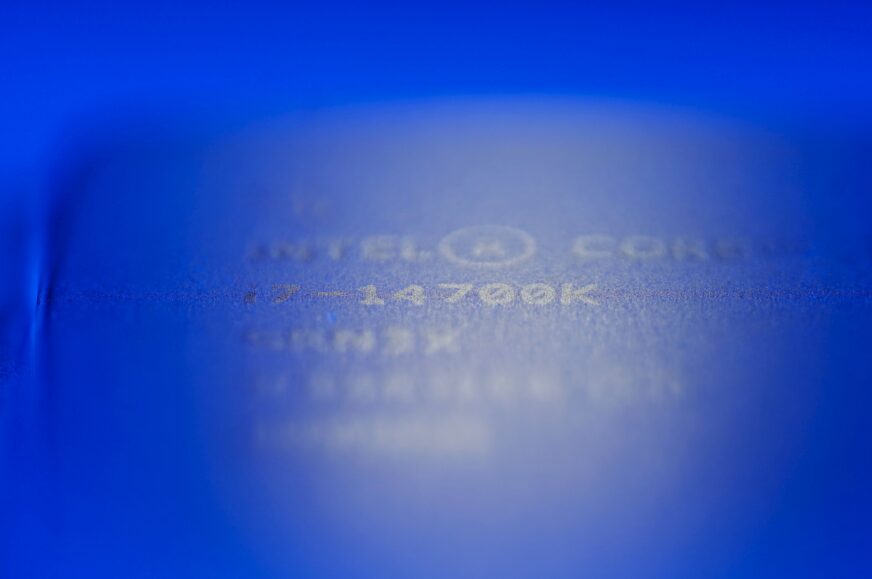Conclusion
The Core i7-14700K processor is the only 125-watt model from the Intel Raptor Lake-S Refresh generation that has undergone a core configuration change between generations. With more “efficient” ones, this processor is halfway to the Core i9-(14900K/13900K), but at the price of a Core i7. The Ci7-14700K is thus significantly more powerful than the Ci7-13700K for the same money. Especially in heavy multi-threaded workloads.
Conclusion
Raw multithreaded performance of the Core i7-14700K in Blender (Cycles) is about 15% higher compared to the Ryzen 9 7900X, up to 20% in Cinebech. But this coupled with a 23% lower power efficiency. While the Ryzen 9 7900X doesn’t even reach 200 watts at maximum power, the Core i7-14700K attacks the 300-watt mark.
In games, at typically lower loads, it’s more moderate. The Core i7 is again the less efficient processor, but the fact that it operates at less than half the power draw (125–135 W) narrows down the difference. Gaming performance (Ci7-14700K and R9 7900X) is otherwise comparable. In some titles Intel has the upper hand, in others it doesn’t, in some places it’s remarkably even and on average we are on a give-or-take equal result. For example, the Core i7 has a more significant edge in Assassin’s Creed: Valhalla, but in Counter-Strike:GO, it’s the Ryzen 9 7900X.
For gaming, the Core i7-14700K is a great processor, but this also applies to models with fewer cores and threads than the 8+12C/28T. What’s particularly noteworthy here, therefore, is the computing performance that can be applied in multi-threaded tasks. In addition to the performance for 3D rendering that we’ve already written about, the Core i7-14700K has very high performance for video encoding with x264/x265 encoders as well. The latter is between the competing Ryzen 9 7900X and the Core i9-13900K. The Ci7-14700K also takes a leap from its predecessor (Ci7-13700K) in (de)encryption and (de)compression of file archives. We measured the largest difference at 24% (in the 7-zip). Raptor Lake Refresh also performs well in physics simulations and mathematical calculations, where the Core i7-14700K beats the R9 7900X in most cases.
Then we also have results from the video content creator environment, where in Adobe Premiere Pro and DaVinci Resolve (Studio), it’s like a seesaw – in some of the subtests, Intel (14700K) is on top, in others it’s AMD (7900X). In the photo editing apps we tested, the Core i7 usually scores higher than the Ryzen. Whether it’s working in Adobe Photoshop and Lightroom, Affinity Photo or in the freeware XnView.But there are also situations where the Core i7-14700K is not enough for the Ryzen 9 7900X, such as for example, when converting RAWs in Zoner photo Studio X or in Topaz Labs AI Apps. In these, AMD processors have a big lead, mainly because of VNNI support.
Intel also managed to beat AMD’s rival processor in single-threaded performance, which can be seen both in shorter encoding times for audio recordings (purely single-threaded tasks) and also in web environments. In the Octane (2.0) and Speedometer tests, the Core i7-14700K garners higher rankings and is more nimble in practice. It’s not a big difference, but the Ryzen 9s (including the 7950X) underperform here. And that’s not just in terms of speed, but power draw as well. The Core i7-14700K’s power draw in single-core load tends to be lower (putting AMD’s processors in the position of being less efficient is also the I/O chiplet, whose power supply also costs something). In idle mode, where only the Windows OS desktop is active with the necessary background overhead processes, the Core i7-14700K versus the Ryzen 9 7900X ends in a draw (18.4 vs. 18.6 W).
Worse Core i7 efficiency is associated with heavier and heavy workloads. There, power draw reaches levels at which it is very difficult for ordinary coolers to keep the hottest cores below 100 °C. When measuring power draw, the values from the start of the tests jumped above 360 W during spikes. For the processor itself, it will be a little less, because the technique of our measurements also takes into account the losses on the VRM, but still, the power draw of this processor is very high. Even 10W higher than the Core i9-13900K. The latter does have more cores, but with the Core i7-14700K it’s the higher clock speeds that drive the processor into inefficiency.
Despite the fact that the Core i7-14700K can be considered a processor that is more demanding to operate and high power draw and high temperatures are both disadvantages (requiring, by the way, a more expensive cooler, which is also the case with Ryzen 9), it is still a top-notch processor. One that has a price-to-performance ratio that is favorable by high-end standards. Especially if you opt for a platform with DDR4 memory, which is still significantly cheaper per gigabyte compared to DDR5. But the difference in performance is not dramatic (see tests of Gigabyte Z690 Gaming X DDR4 with Core i9-12900K for proof). In addition, the Intel Core i7-14700K is a versatile processor suitable for all types of tasks that a typical desktop user may encounter. It’s also at at the top in gaming (though still below the Ryzen 7 7800X3D) or in single-threaded tasks, where AMD’s Ryzen 7000 processors are already at the lower ranks. So the “Top-notch” editorial award for the Core i7-14700K is well deserved, and we’ll see where the Core i9-14900K takes things next.
English translation and edit by Jozef Dudáš
| Intel Core i7-14700K |
| + Very high multi-threaded performance |
| + As many as 20 cores and 28 threads... |
| + ... with a fairly significant increase in E core count over the Core i7-13700K |
| + Priced at the Core i7-13700K level... |
| + ... and an improved price/performance ratio that is impressive even compared to AMD's competing platform |
| + Top-notch gaming performance |
| + ... and also top-notch single-threaded performance |
| + "Universal" processor, fits every use case |
| + Very high performance per clock (IPC) |
| + APO support, which only applies to Raptor Lake Refresh processors |
| + Modern 7nm manufacturing node |
| - High temperatures even with a powerful cooler |
| - Compared to Ryzen 9 7900X, weaker efficiency (performance per watt) under heavier multi-threaded load |
| Approximate retail price: 409 EUR |
We are grateful to Datacomp e-shop for cooperation in providing the tested hardware
Special thanks also to Blackmagic Design (for DaVinci Resolve Studio license), Topaz Labs (for DeNoise AI, Gigapixel AI and Sharpen AI licenses) and Zoner (for Photo Studio X license)
- Contents
- Intel Core i7-14700K in detail
- Methodology: performance tests
- Methodology: how we measure power draw
- Methodology: temperature and clock speed tests
- Test setup
- 3DMark
- Assassin’s Creed: Valhalla
- Borderlands 3
- Counter-Strike: GO
- Cyberpunk 2077
- DOOM Eternal
- F1 2020
- Metro Exodus
- Microsoft Flight Simulator
- Shadow of the Tomb Raider
- Total War Saga: Troy
- Overall gaming performance
- Gaming performance per euro
- PCMark and Geekbench
- Web performance
- 3D rendering: Cinebench, Blender, ...
- Video 1/2: Adobe Premiere Pro
- Video 2/2: DaVinci Resolve Studio
- Graphics effects: Adobe After Effects
- Video encoding
- Audio encoding
- Broadcasting (OBS and Xsplit)
- Photos 1/2: Adobe Photoshop and Lightroom
- Photos 2/2: Affinity Photo, Topaz Labs AI Apps, ZPS X, ...
- (De)compression
- (De)encryption
- Numerical computing
- Simulations
- Memory and cache tests
- Processor power draw curve
- Average processor power draw
- Performance per watt
- Achieved CPU clock speed
- CPU temperature
- Conclusion











Majority tends to hate 14th gen (no progress etc), but it’s almost totally win-win generation: it reduces “unnoticeably slower” 13th gen prices; Intel’s partners like DELL are happy to get next-gen CPUs for their next-gen computers and Intel himself can boast that they supported LGA 1700 with three generations. Cherry on top is 14700K which offers almost maximum performance of 1700 for only i7 money. Now let’s wait for lower-end chips – already 13th gen beats here AMD with multicore performance combined with option to go cheaper DDR4 route what is sensible for lower-end workstation builds. That’s why I see 14th gen as almost totally win-win. Almost because only losers here will be reselling values of most of 1700 chips (especially massacrated by 14700K itself), but it’s natural downside of longer socket support.
Thanks for the addition. The explicit specification of the Ci7-14700K suitability for cheaper workstations with DDR4 memory is probably missing in the text of our article. And yet in this respect, as long as all 20 cores scale, there really is no alternative with a comparable price/performance ratio.
It seems to me that most of the commercial reviewers put a lot of emphasis on the high power draw, which is, of course, a fact, but there is a little bit of a “B” missing in the fact that at lower, for example, gaming loads, the power efficiency with Ryzen 9 is comparable or even more attractive (in a single-threaded load). And who doesn’t like the 300W, can adjust the power limits at will and in many multi-threaded applications the Ci7-14700K will still be on top compared to the R9 7900X even at the same power draw. We have not tested this situation (Ci7-14700K vs. R9 7900X) directly at lower power draws, but if you look at our motherboard tests, you will see that the Core i9-13900K is only a couple % slower at PL2 limited to the TDP level (125 W) compared to the R9 7950X with a TDP of 105 W (PPT of 142 W). And I feel the difference between Core i7-14700K and Ryzen 9 7900X will be even smaller.
Intel just took from AMD their few years ago signature multicore performance for the money. Especially with equipping lower-to-mid-range chips with plenty of e-cores allowing them to beat here R5 and R7.
Problem with awful power draw, it’s mostly about these chips just being able to pull crazy numbers when ulimited. My 13900K scores in CB23 Multi ~35500 points with PL1=PL2=200W. Scoring even 41000 or having the heaviest on multicore tasks done 15% faster for the price of 300+W attacing me; needing damn AiO and way more noise to handle it? Bad deal to me. Or another fun fact in terms of efficiency: 13900K can give performance of unltimited 13700K for just half of i7’s power draw. Tests show 13700K needing to pull at least 250W to score up to 31K, but my chip did exactly 30766 with PL1=PL2=125W – quite unusual perspective, but potentially attractive in terms of heat; noise or eco.
Ryzens 7000 are amazing in energy efficiency and, if I remember well, 7950X is even better than 13900K here, but not many add here that Ryzens also tend to be harder to cool. Some polish youtuber made a graph showing maybe even these exact chips power normalized on various levels and how hot they get then. Ryzen pulling the same power tends to be ~10C hotter. I rather don’t watch him, so don’t know how reliable are his numbers, but such tendency is quite known. And it makes Ryzen’s eficiency not just better, but coming with stinky addition of higher noise and temperatures. Reducing them to Intel’s level would somehow melt this better efficiency…